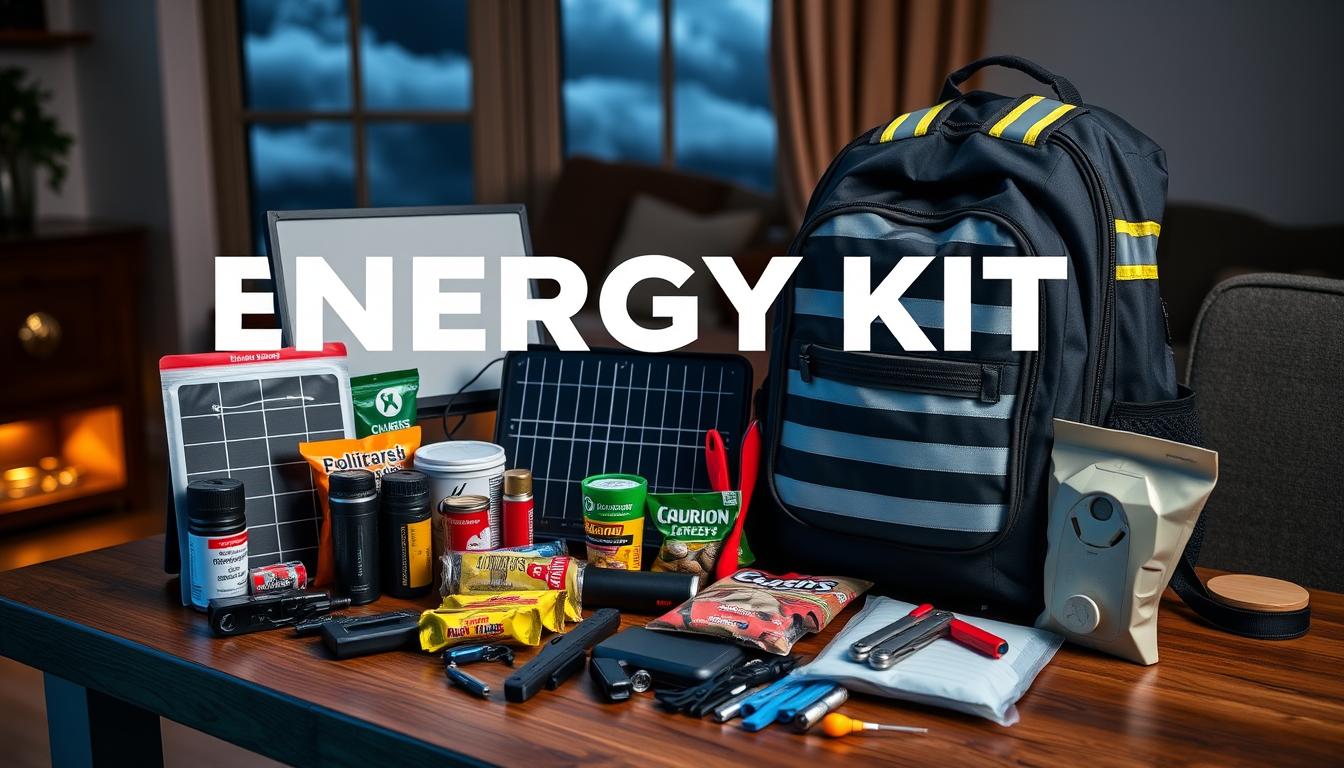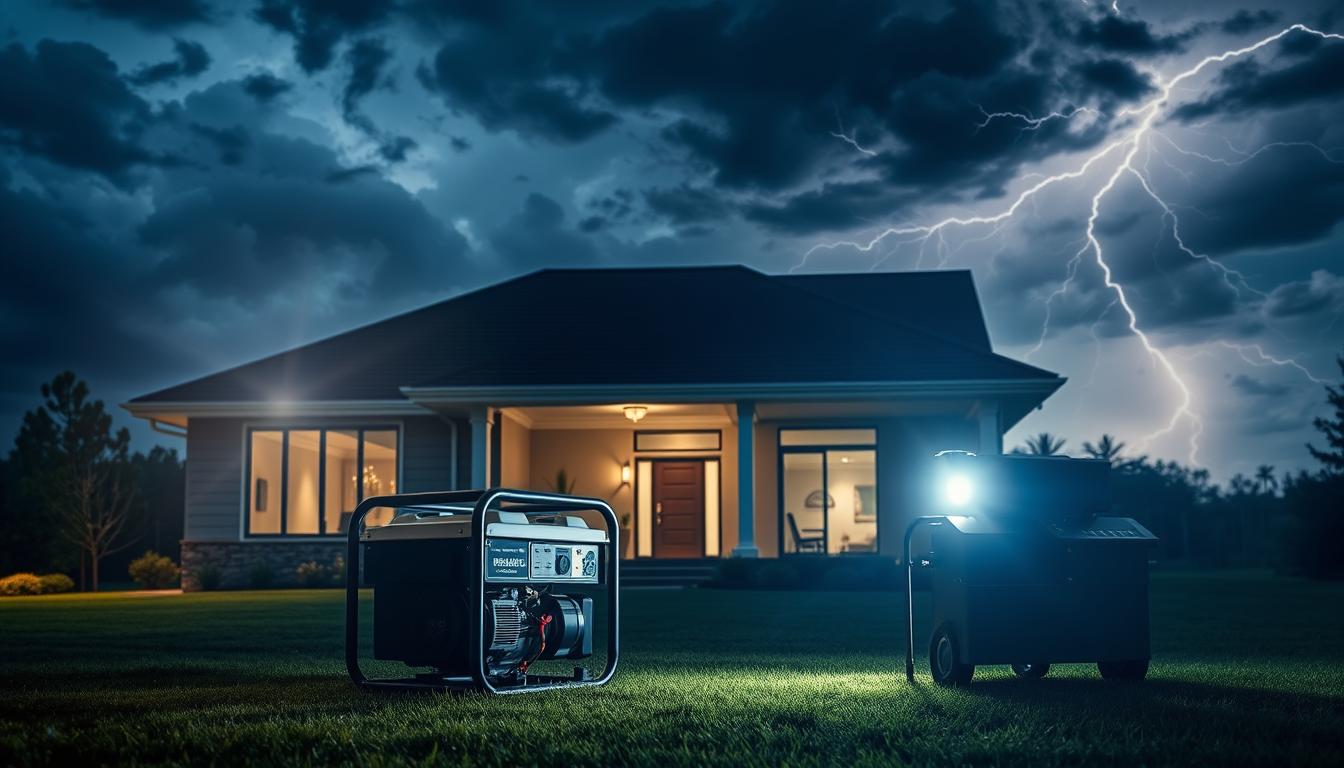Power outages happen a lot in the U.S., with each household facing about six hours of darkness yearly. This is because the country’s old electrical systems can’t handle today’s tech needs. Weather like thunderstorms, earthquakes, and hurricanes often causes these problems.
While most outages are short, some can last for hours or even days. This can be dangerous, causing damage, health risks, and making it hard to use important medical gear. It’s key to have an emergency energy kit ready to keep your family safe.
Key Takeaways
- Power outages in the U.S. last an average of 6 hours per year, with severe weather as the primary cause.
- Extended blackouts can lead to property damage, safety risks, and challenges managing medical needs.
- Building an emergency energy kit is essential for weathering prolonged power interruptions.
- Backup power solutions, emergency lighting, and communication tools are crucial kit components.
- Proper preparation and planning can help protect your family and home during power outages.
Understanding Power Outage Statistics and Risks in the US
Power outages are common in the United States. On average, people face six hours of interruptions each year. Severe weather, like thunderstorms and hurricanes, is the main cause. Other reasons include equipment failures and human mistakes.
Long power cuts can really disrupt our lives. They affect things like refrigeration and heating systems. In fact, these outages cost the US economy between $20 billion and $55 billion each year.
Average Duration of Power Interruptions
Weather-related power outages have doubled since 2000, the U.S. Department of Energy says. There are about 90 significant outages per year. This shows how vulnerable our electrical grid is and why we need to be ready for long power cuts.
Common Causes of Power Outages
- Severe weather events (e.g., thunderstorms, hurricanes, high winds, ice storms)
- Equipment failures
- Natural causes (e.g., animals interfering with power lines)
- Human error
Impact on Daily Life
When the power goes out, it can really mess up our daily routines. It affects things like refrigeration and heating. It’s very important to be ready for these outages and lessen their impact.
Essential Components of an Emergency Energy Kit
Having an emergency energy kit ready can be a lifesaver during power outages. Make sure you have these key items:
- Water – One gallon per person per day for at least 3-14 days
- Non-perishable food – Canned goods, dehydrated meals, and energy bars with long shelf lives
- Flashlights – LED models for maximum battery life
- Battery-powered or hand-crank radio
- Extra batteries
- First aid kit
- Medications
- Multi-purpose tools
- Sanitation items – Toilet paper, soap, hand sanitizer
- Personal documents – ID, insurance cards, cash
- Cell phone chargers
If you have medical equipment that needs electricity, add backup power like portable generators or solar kits. Also, include books, games, and puzzles to keep everyone entertained during long outages.
With these items in your emergency kit, you’ll be ready for any power outage. You’ll keep your family safe and comfortable until the power returns.

“Preparing for a power outage is crucial, as extended blackouts can impact an entire community. Having the right supplies on hand can make all the difference in staying safe and comfortable until the power is restored.”
Emergency Energy Kits: What You Need to Prepare for Power Outages
Having an emergency energy kit is key when the power goes out. It helps you stay safe and comfortable. Your kit should have all the essentials for your family.
Basic Survival Supplies
Your kit must have basic survival items. This includes three days’ worth of water, one gallon per person. Also, add non-perishable food, a first aid kit, and any needed medicines.
Power and Lighting Solutions
For light and to charge devices, include power and lighting solutions. You’ll need flashlights, battery-powered lamps, and portable power banks. These ensure you have enough light and can keep your devices charged.
Communication Tools
Staying in touch is vital during an outage. Your kit should have a battery-powered or hand-crank radio, like a NOAA Weather Radio. Also, keep cell phones charged with backup chargers. A non-cordless landline phone is a good idea too.
Don’t forget to include important documents, extra cash, and a list of emergency contacts. A well-stocked emergency energy kit prepares you for power outages. It keeps your family safe and comfortable during tough times.

Food Storage and Preservation During Blackouts
When the power goes out, it’s key to store food safely. This helps avoid foodborne illnesses. Here are some important tips:
- Keep refrigerator and freezer doors closed as much as possible. An unopened refrigerator will keep food cold for about 4 hours, while a full freezer can maintain its temperature for approximately 48 hours.
- Use coolers with ice to store perishable items if the outage extends beyond 4 hours. Fifty pounds of dry ice can sustain an 18 cubic foot fully stocked freezer for up to two days.
- Keep food in a dry, cool spot and covered at all times. Discard any food that has been exposed to temperatures above 40°F (4°C) for 2 hours or more, or any food with an unusual odor, color, or texture.
Being careful with food safety during power outages is crucial. If perishable food has been at room temperature for 2 hours or more (or 1 hour in temperatures exceeding 90°F), it should be discarded to prevent foodborne illness. On the other hand, food that still contains ice crystals or is at or below 40°F is safe to refreeze or cook after a power outage.
| Statistic | Value |
|---|---|
| Refrigerator Preservation Time | About 4 hours |
| Full Freezer Preservation Time | Approximately 48 hours |
| Temperature Threshold for Food Discard | Above 40°F (4°C) for more than 2 hours |
By following these guidelines, you can help ensure the food safety during power outages and keep your family nourished during a blackout.

Portable Power Solutions and Backup Systems
Portable power solutions and backup systems are key for reliable power during outages. They include battery banks, solar chargers, hand-crank generators, and emergency radios. These tools keep your devices charged and your family connected.
Battery Banks and Solar Chargers
Portable power banks are vital for any emergency kit. They offer hours of power for phones, tablets, and more. Solar chargers use sunlight to charge your devices, making them great for long outages or outdoor trips.
Hand-Crank Generators
Hand-crank generators are a reliable manual power source. They can charge your electronics, like radios and flashlights, without batteries or fuel. They’re perfect when other power sources are not available.
Emergency Radios
Emergency radios are essential for staying informed during blackouts. Choose models with battery, solar, or hand-crank power options. These radios keep you updated with news and updates, even without power.
For full home backup power, consider larger systems or generators. They offer strong and lasting power during long outages. Finding the right solution for your needs keeps your family safe and comfortable during power crises.

Safe Generator Usage and Maintenance
A generator can be a lifesaver during a power outage. It keeps your home running. But, using or maintaining a generator wrong can be very dangerous. It can even lead to carbon monoxide poisoning. Here are some key tips to use your generator safely:
- Never use a generator indoors or in small spaces. Carbon monoxide is colorless and odorless. It can be deadly. Always keep your generator at least 20 feet away from windows, doors, and vents.
- Put carbon monoxide alarms in central spots on every floor. These alarms can spot this dangerous gas. They will warn you to take action right away.
- Get a professional electrician to set up a safe connection for your generator. Bad installation can cause power surges and harm your appliances.
- Keep your generator in good shape and practice using it. This makes sure it works right and you know how to use it.
- Store fuel safely and have enough for long power outages. Gasoline and propane should be in approved containers. Keep them away from any fire sources.
By following these generator safety, carbon monoxide prevention, and backup power systems tips, you can keep your family safe. Your home will stay powered even during long blackouts.
“The Red Cross recommends a generator purchase for homes during power outages, as businesses and critical infrastructure can be affected for days or even weeks.”

First Response Actions When Power Goes Out
When the power goes out, it’s important to act fast. We need to check for safety and protect our stuff. This keeps our family safe and our things working.
Immediate Safety Checks
When the lights go out, gather everyone in a safe, lit room. Get your emergency kit ready. It should have flashlights, lamps, and a radio. This helps you stay safe and informed during the power outage response.
Appliance Protection
Unplug sensitive devices like computers and TVs right away. This protects them from power surges. It also saves you money and makes sure they work when the power comes back.
Communication Protocol
It’s key to keep in touch during a blackout. Check on neighbors and tell your power company about the outage. Use battery or hand-crank radios for updates from local authorities.
Staying calm and prepared is key during a power outage. By following these steps, you can handle the blackout well. This keeps your family safe and your life running smoothly.
Special Considerations for Vulnerable Populations
When power goes out, people who need electric medical gear need a solid backup plan. The elderly and disabled might need extra help to stay safe. It’s important to focus on these groups to help them get through blackouts.
Keeping medicines cool is key for those who need refrigeration. Build a network of family, friends, and neighbors to check on these folks. Also, think about registering with local authorities or power companies if you have special medical needs.
- Develop a backup power plan for medical equipment and devices
- Ensure medication that requires refrigeration has a proper storage plan
- Establish a support network to assist vulnerable individuals during outages
- Register with local authorities or power companies for priority support
Working together is crucial to protect our most vulnerable neighbors. By joining forces, we can make sure everyone in our community stays safe and strong during power outages.
| Vulnerable Group | Preparedness Level | Health Concern | Outage Notification Awareness |
|---|---|---|---|
| Elderly (≥65 years) | 65% | Higher | Low |
| Households with Electric-Dependent Members | 70% | Higher | Low |
| Households with Assistance-Dependent Members | 59% | Higher | Low |
Understanding the special needs of vulnerable groups helps us prepare better. This way, we can make sure everyone is taken care of when the lights go out.
“Preparedness is the key to resilience. By investing in the safety and well-being of our most vulnerable neighbors, we can build a stronger, more connected community that can weather any storm.”
Maintaining and Updating Your Emergency Kit
Getting an emergency kit ready is just the start to keep your family safe during power outages. We need to check and update our kits often. This means looking at food and water expiration dates, replacing flashlight and radio batteries, and updating contact info and documents.
It’s important to swap out the non-perishable food and water in your kit regularly. This keeps them fresh and ready for use. Also, remember to restock any items you used in a previous outage. Keeping up with emergency kit care helps us stay ready for the next power outage.
As new advice on emergency prep comes out, we should update our kits. This might mean adding things like solar chargers or new first-aid items. By staying informed and active, we make sure our kits are always up to date for our family’s needs.
| Conclusion: Be Prepared for Power Outages Having an emergency energy kit is crucial for staying safe during blackouts. But what if you could avoid outages altogether? Edison’s ‘Lost Invention’ offers a groundbreaking solution that generates unlimited energy on demand—no grid required. Don’t wait for the next outage. Learn more about this revolutionary energy technology and how it can power your home, anytime. Click here to discover Edison’s Lost Invention and unlock endless energy on demand! |
FAQ
What is the average duration of power interruptions in the United States?
In the U.S., people face about six hours of power loss each year.
What are the common causes of power outages in the United States?
Severe weather like thunderstorms and hurricanes often causes outages. High winds and ice storms also play a role. Other reasons include equipment failures, animals on power lines, and human mistakes.
How do extended power outages impact daily life?
Long blackouts can mess up our daily routines. They affect things like refrigeration, water, and heating. They also disrupt our use of electronic devices.
What are the essential components of an emergency energy kit?
An emergency kit should have water, non-perishable food, and flashlights. It should also include a battery-powered or hand-crank radio, extra batteries, and a first aid kit. Don’t forget medications, multi-purpose tools, sanitation items, personal documents, cell phone chargers, and cash.
What are the basic survival supplies needed during a power outage?
Basic needs include water, non-perishable food, and first aid items.
What power and lighting solutions should be included in an emergency kit?
Your kit should have flashlights, battery-powered lamps, and portable power banks.
What communication tools are essential during a power outage?
Communication tools are key. Include a battery-powered or hand-crank radio, fully charged cell phones with chargers, and a non-cordless landline phone.
How should I store and preserve food during a blackout?
Keep fridge and freezer doors closed. Use coolers with ice for perishables if the outage lasts more than 4 hours. Discard food exposed to high temperatures or with unusual smells, colors, or textures.
What portable power solutions are available for an emergency kit?
Options include battery banks, solar chargers, and hand-crank generators. They offer manual power for small devices.
How can I safely use a generator during a power outage?
Never use generators indoors due to carbon monoxide risks. Place them at least 20 feet away from windows and vents. Install carbon monoxide alarms. Have a pro install a safe connection. Regularly maintain your generator and practice using it before emergencies.
What are the first response actions when the power goes out?
Check on family members and gather in one room. Get your emergency kit and set up lighting. Unplug sensitive electronics and appliances. Check circuit breakers and contact neighbors. Report the outage to your power company. Secure refrigerated items and check on vulnerable neighbors.
What special considerations are needed for vulnerable populations during power outages?
People with electric-powered medical equipment need a backup power plan. Elderly or disabled individuals may need extra help. Ensure medication storage and create a support network. Consider registering with local authorities if you have special medical needs.
How do I maintain and update my emergency energy kit?
Check and rotate food and water in your kit regularly. Replace batteries in flashlights and radios yearly. Update your emergency contact list and important documents. Review and practice your emergency plan often. Restock your kit after using it and stay informed about new emergency preparedness tips.
Source Links
- Power Outage Emergency Kit Checklist Guide – https://energyharbor.com/en/energy-resources/moving-center/power-outage-emergency-kit-checklist-guide
- Emergencies Cyber Power Outage – NYC Health – https://www.nyc.gov/site/doh/health/emergency-preparedness/emergencies-cyber-power-outage.page
- Power Outage Preparedness: A Complete Guide – https://www.ladybugenergy.com/posts/power-outage-preparedness-a-complete-guide
- Essential Power Outage Emergency Kit – EcoWatch – https://www.ecowatch.com/electricity/essential-power-outage-emergency-kit
- Power Outage Safety – https://www.redcross.org/get-help/how-to-prepare-for-emergencies/types-of-emergencies/power-outage.html?srsltid=AfmBOorQft_7Fa_Cdo2YaVuFOS2YVuX4umT8TouClu1o7AJ7HLIs_l8L
- Tips to Prepare for a Power Outage – https://www.safetyactioncenter.pge.com/articles/11-tips-prepare-power-outage
- Power Outage Kit List, Power Outage Emergency Kit Checklist – https://quickelectricity.com/power-outage-kit-list/
- How to Prepare for Power Outages – Sequachee Valley Electric Cooperative – https://svalleyec.com/how-to-prepare-for-power-outages/
- 12 tips to prepare for a power cut – https://www.nationalgrid.com/power-cuts/tips-prepare-for-power-cut
- Food and Water Safety During Power Outages and Floods – https://www.fda.gov/food/buy-store-serve-safe-food/food-and-water-safety-during-power-outages-and-floods
- How to Prepare for a Blackout or Long-Term Power Outage – https://www.moreprepared.com/preparing-for-blackouts?srsltid=AfmBOop7Jh0TXo682Kvlr1i_q9uQAH8ljX9KzvHRfa3IrvQDzN1SXpqE
- Best Non-Perishable Foods to Stockpile for an Emergency – https://www.realsimple.com/food-recipes/shopping-storing/emergency-foods
- Emergency Power Outage Preparation – https://www.powerplus.com/industrial-power-blog/emergency-power-outage-preparation/?s8-datarepeater1_rows=170
- Home Backup Power 101: How to Prepare for a Power Outage – https://goalzero.com/blogs/news/home-backup-power-101-how-to-prepare-for-a-power-outage?srsltid=AfmBOopwGi7arFyPtdhaFn0QqOX6XQIP3AaKdfwTHHbXXVymS_RyVHs_
- What’s your emergency power supply at home? – https://budgetlightforum.com/t/what-s-your-emergency-power-supply-at-home/64919
- How to Prepare for a Power Outage – https://norwall.com/power-expert/how-to-prepare-for-power-outage/
- How to Prepare for Power Outages and Blackouts [2024] – https://www.thegoodelectrician.com/blog/how-to-prepare-for-power-outages-and-blackouts/
- What to do when the power goes out – https://www.constellation.com/energy-101/weather-preparedness/what-to-do-when-power-goes-out.html
- 7-Step Power Outage Emergency Response Plan [+ Template] – https://www.alertmedia.com/blog/power-outage-emergency-response-plan/
- Power Outage Safety – https://www.redcross.org/get-help/how-to-prepare-for-emergencies/types-of-emergencies/power-outage.html?srsltid=AfmBOoqbns_0Y5xEAIIbM10c0IkDNtrUZWWWnGrgF6CPH6aXnCGBvcTB
- Home Safety During Power Outages: Preparedness And Alternative Lighting – StaySafe.org – https://staysafe.org/home-safety/home-safety-during-power-outages/
- How to Create a Contingency Plan & Prepare for Power Outages – https://www.foleyinc.com/how-to-create-a-contingency-plan-and-prepare-for-power-outages/
- Power Outage Preparedness and Concern among Vulnerable New York City Residents – https://academicworks.cuny.edu/cgi/viewcontent.cgi?article=2123&context=bb_pubs
- What to put in your power outage emergency kit – https://outliermedia.org/emergency-kit-power-outages-detroit-preparation/
- Power Outage Safety – https://www.redcross.org/get-help/how-to-prepare-for-emergencies/types-of-emergencies/power-outage.html?srsltid=AfmBOopu770-k4y85nnnSLHi1VA0c8DPVX5UnkeZU_mXXHN_OLqWjsIe
- What you need in a home emergency kit – Lockhart Power Company – https://lockhartpower.com/what-you-need-in-a-home-emergency-kit/
Affiliate Disclosure: This article contains affiliate links, meaning I may earn a commission if you click through and make a purchase, at no extra cost to you.



